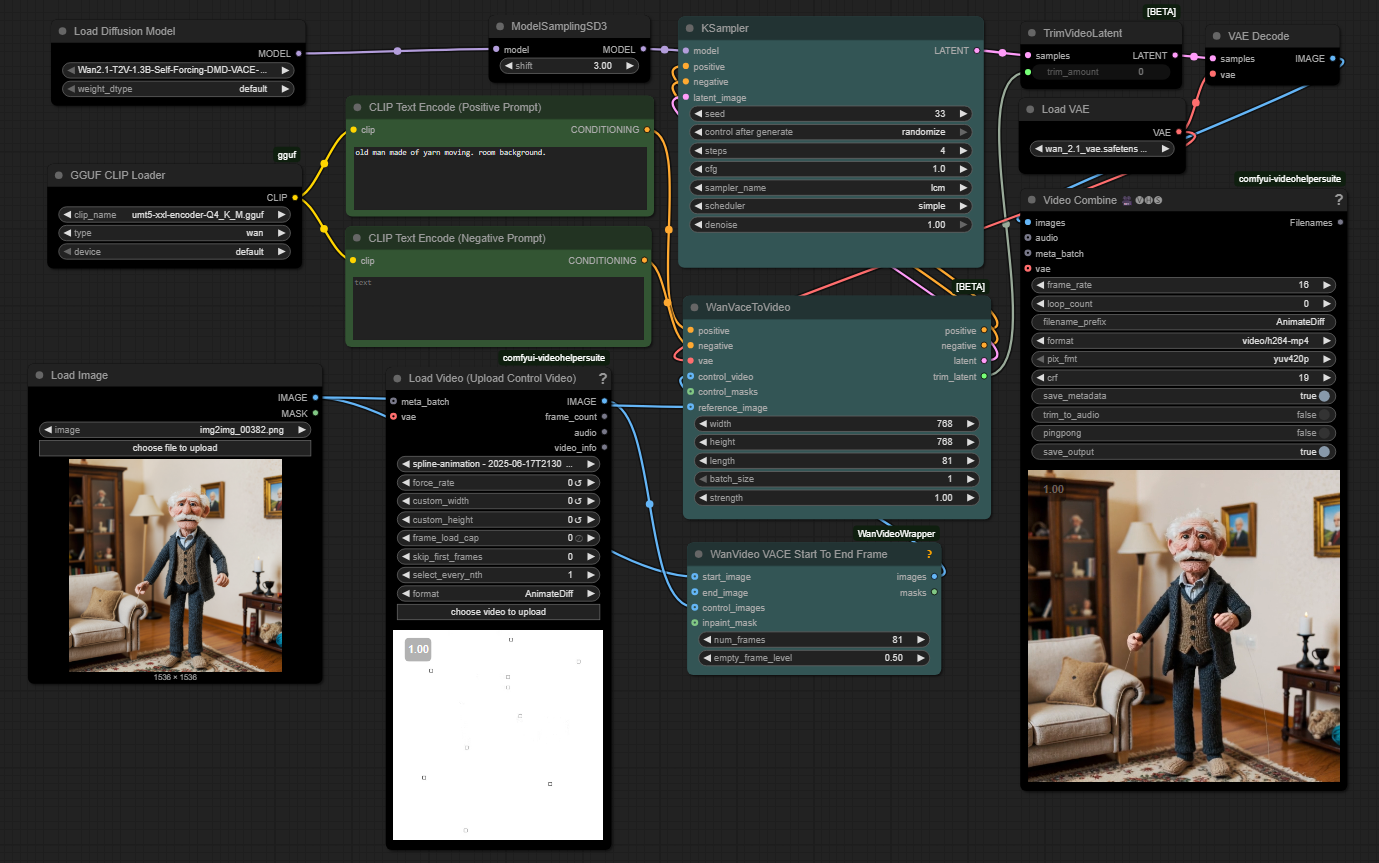BREAKING NEWS
LATEST POSTS
-
AccVideo – Accelerating Video Diffusion Model with Synthetic Dataset
https://aejion.github.io/accvideo
https://github.com/aejion/AccVideo
https://huggingface.co/aejion/AccVideo
AccVideo is a novel efficient distillation method to accelerate video diffusion models with synthetic datset. This method is 8.5x faster than HunyuanVideo.
-
Mastering Camera Shots and Angles: A Guide for Filmmakers
https://website.ltx.studio/blog/mastering-camera-shots-and-angles
1. Extreme Wide Shot

2. Wide Shot

3. Medium Shot

4. Close Up

5. Extreme Close Up

-
Bennett Waisbren – ChatGPT 4 video generation
1. Rankin/Bass – That nostalgic stop-motion look like Rudolph the Red-Nosed Reindeer. Cozy and janky.
2. Don Bluth – Lavish hand-drawn fantasy. Lush lighting, expressive eyes, dramatic weight.
3. Fleischer Studios – 1930s rubber-hose style, like Betty Boop and Popeye. Surreal, bouncy, jazz-age energy.
4. Pixar – Clean, subtle facial animation, warm lighting, and impeccable shot composition.
5. Toei Animation (Classic Era) – Foundation of mainstream anime. Big eyes, clean lines, iconic nostalgia.
6. Cow and Chicken / Cartoon Network Gross-Out – Elastic, grotesque, hyper-exaggerated. Ugly-cute characters, zoom-ins on feet and meat, lowbrow chaos.
7. Max Fleischer’s Superman – Retro-futurist noir from the ’40s, bold shadows and heroic lighting.
8. Sylvain Chomet – French surrealist like The Triplets of Belleville. Slender, elongated, moody weirdness.
FEATURED POSTS
-
Academy Award for Best Cinematography – Top 20 Winners Breakdown
www.studiobinder.com/blog/academy-award-for-best-cinematography-winners
2019 – Roger Deakins, 1917
2018 – Alfonso Cuarón, Roma
2017 – Roger Deakins, Blade Runner 2049
2016 – Linus Sandgren, La La Land
2015 – Emmanuel Lubezki, The Revenant
2014 – Emmanuel Lubezki, Birdman or (The Unexpected Virtue of Ignorance)
2013 – Emmanuel Lubezki, Gravity
2012 – Claudio Miranda, Life of Pi
2011 – Robert Richardson, Hugo
2010 – Wally Pfister, Inception
2009 – Mauro Fiore, Avatar
2008 – Anthony Dod Mantle, Slumdog Millionaire
2007 – Robert Elswit, There Will Be Blood
2006 – Guillermo Navarro, Pan’s Labyrinth
2005 – Dion Beebe, Memoirs of a Geisha
2004 – Robert Richardson, The Aviator
2003 – Russell Boyd, Master and Commander: The Far Side of the World
2002 – Conrad L. Hall, Road to Perdition
2001 – Andrew Lesnie, The Lord of the Rings: The Fellowship of the Ring
2000 – Peter Pau, Crouching Tiger, Hidden Dragon
1999 – Conrad L. Hall, American Beauty
1998 – Janusz Kamiński, Saving Private Ryan
1997 – Russell Carpenter, Titanic
1996 – John Seale, The English Patient
1995 – John Toll, Braveheart
1994 – John Toll, Legends of the Fall
1993 – Janusz Kamiński, Schindler’s List
1992 – Phillipe Rousselot, A River Runs Through It
1991 – Robert Richardson, JFK
1990 – Dean Semler, Dances with Wolves
1989 – Freddie Francis, Glory
1988 – Peter Biziou, Mississippi Burning
1987 – Vittorio Storaro, The Last Emperor
1986 – Chris Menges, The Mission
1985 – David Watkin, Out of Africa
1984 – Chris Menges, The Killing Fields
1983 – Sven Nykvist, Fanny and Alexander
1982 – Billy Williams, Ronnie Taylor, Gandhi
1981 – Vittorio Storaro, Reds
1980 – Geoffrey Unsworth, Ghislain Cloquet, Tess
1979 – Vittorio Storaro, Apocalypse Now
1978 – Néstor Almendros, Days of Heaven
1977 – Vilmos Zsigmond, Close Encounters of the Third Kind
1976 – Haskell Wexler, Bound for Glory
1975 – John Alcott, Barry Lyndon
1974 – Fred J. Koenekamp, Joseph Biroc, The Towering Inferno
1973 – Sven Nykvist, Cries and Whispers
1972 – Geoffrey Unsworth, Cabaret
1971 – Oswald Morris, Fiddler on the Roof
1970 – Freddie Young, Ryan’s Daughter
1969 – Conrad Hall, Butch Cassidy and the Sundance Kid
1968 – Pasqualino De Santis, Romeo and Juliet
1967 – Burnett Guffey, Bonnie and Clyde
1966 – Ted Moore, (Color) A Man for All Seasons
Haskell Wexler, (B&W) Who’s Afraid of Virginia Woolf?
1965 – Freddie Young, (Color) Doctor Zhivago
(Ernest Laszlo), (B&W) Ship of Fools
1964 – Harry Stradling, (Color) My Fair Lady (
Walter Lassally, (B&W) Zorba the Greek
1963 – Leon Shamroy, (Color) Cleopatra
James Wong Howe, (B&W) Hud
1962 – Freddie Young, (Color) Lawrence of Arabia
Jean Bourgoin, Walter Wottitz, (B&W) The Longest Day
1961 – Daniel L. Fapp, (Color) West Side Story
Eugen Schüfftan, (B&W) The Hustler
1960 – Russell Metty, (Color) Spartacus
Freddie Francis, (B&W) Sons and Lovers
1959 – Robert Surtees, (Color) Ben-Hur
William C. Mellor, (B&W) The Diary of Anne Frank
1958 – Joseph Ruttenberg, (Color) Gigi
Sam Leavitt, (B&W) The Defiant Ones
1957 – Jack Hildyard, The Bridge on the River Kwai
1956 – Lionel Lindon, (Color) Around the World in 80 Days
Joseph Ruttenberg, (B&W) Somebody Up There Likes Me
1955 – Robert Burks, (Color) To Catch a Thief
James Wong Howe, (B&W) The Rose Tattoo
1954 – Milton Krasner, (Color) Three Coins in the Fountain
Boris Kaufman, (B&W) On the Waterfront
1953 – Loyal Griggs, (Color) Shane
Burnett Guffey, (B&W) From Here to Eternity
1952 – Winton C. Hoch, Archie Stout, (Color) The Quiet Man
Robert Surtees, (B&W) The Bad and the Beautiful
1951 – Alfred Gilks, John Alton, (Color) An American in Paris
William C. Mellor, (B&W) A Place in the Sun
1950 – Robert Surtees, (Color) King Solomon’s Mines
Robert Krasker, (B&W) The Third Man
1949 – Winton C. Hoch, (Color) She Wore a Yellow Ribbon
Paul C. Vogel, (B&W) Battleground
1948 – Joseph Valentine, William V. Skall, Winton C. Hoch, (Color) Joan of Arc
William Daniels, (B&W) The Naked City
1947 – Jack Cardiff, (Color) Black Narcissus
Guy Green, (B&W) Great Expectations
1946 – Charles Rosher, Leonard Smith, Arthur Arling, (Color) The Yearling
Arthur C. Miller, (B&W) Anna and the King of Siam
1945 – Leon Shamroy, (Color) Leave Her to Heaven
Harry Stradling, (B&W) The Picture of Dorian Gray
1944 – Leon Shamroy, (Color) Wilson
Joseph LaShelle, (B&W) Laura
1943 – Hal Mohr, W. Howard Greene, (Color) Phantom of the Opera
Arthur C. Miller, (B&W) The Song of Bernadette
1942 – Leon Shamroy, (Color) The Black Swan
Joseph Ruttenberg, (B&W) Mrs. Miniver
1941 – Ernest Haller, Ray Rennahan, (Color) Blood and Sand
Arthur C. Miller, (B&W) How Green Was My Valley
1940 – George Périnal, (Color) Thief of Bagdad
George Barnes, (B&W) Rebecca
1939 – Ernest Haller, Ray Rennahan, (Color) Gone with the Wind
Gregg Toland, (B&W) Wuthering Heights
1938 – Oliver T. Marsh, Allen Davey, (Color) Sweethearts
Joseph Ruttenberg, (B&W) The Great Waltz
1937 – W. Howard Greene, (Color) A Star is Born
Karl Freund, (B&W) The Good Earth
1936 – W. Howard Greene, Harold Rossen, (Color) The Garden of Allah
Tony Guadio, (B&W) Anthony Adverse
1935 – Hal Mohr, A Midsummer Night’s Dream
1934 – Victor Milner, Cleopatra
1933/32 – Charles Lang, A Farewell to Arms
1932/31 – Lee Garmes, Shanghai Express
1931/30 – Floyd Crosby, Tabu: A Story of the South Seas
1930/29 – Joseph T. Rucker, Willard Van der Veer, With Byrd at the South Pole
1929/28 – Clyde De Vinna, White Shadows in the South Seas
1928/27 – Charles Rosher, Karl Struss, Sunrise: A Song of Two Humans
-
WhatDreamsCost Spline-Path-Control – Create motion controls for ComfyUI
https://github.com/WhatDreamsCost/Spline-Path-Control
https://whatdreamscost.github.io/Spline-Path-Control/
https://github.com/WhatDreamsCost/Spline-Path-Control/tree/main/example_workflows
Spline Path Control is a simple tool designed to make it easy to create motion controls. It allows you to create and animate shapes that follow splines, and then export the result as a
.webmvideo file.
This project was created to simplify the process of generating control videos for tools like VACE. Use it to control the motion of anything (camera movement, objects, humans etc) all without extra prompting.- Multi-Spline Editing: Create multiple, independent spline paths
- Easy To Use Controls: Quickly edit splines and points
- Full Control of Splines and Shapes:
- Start Frame: Set a delay before a spline’s animation begins.
- Duration: Control the speed of the shape along its path.
- Easing: Apply
Linear,Ease-in,Ease-out, andEase-in-outfunctions for smooth acceleration and deceleration. - Tension: Adjust the “curviness” of the spline path.
- Shape Customization: Change the shape (circle, square, triangle), size, fill color, and border.
- Reference Images: Drag and drop or upload a background image to trace paths over an existing image.
- WebM Export: Export your animation with a white background, perfect for use as a control video in VACE.

-
Gamma correction

http://www.normankoren.com/makingfineprints1A.html#Gammabox
https://en.wikipedia.org/wiki/Gamma_correction
http://www.photoscientia.co.uk/Gamma.htm
https://www.w3.org/Graphics/Color/sRGB.html
http://www.eizoglobal.com/library/basics/lcd_display_gamma/index.html
https://forum.reallusion.com/PrintTopic308094.aspx
Basically, gamma is the relationship between the brightness of a pixel as it appears on the screen, and the numerical value of that pixel. Generally Gamma is just about defining relationships.
Three main types:
– Image Gamma encoded in images
– Display Gammas encoded in hardware and/or viewing time
– System or Viewing Gamma which is the net effect of all gammas when you look back at a final image. In theory this should flatten back to 1.0 gamma.
(more…)
-
sRGB vs REC709 – An introduction and FFmpeg implementations

1. Basic Comparison
- What they are
- sRGB: A standard “web”/computer-display RGB color space defined by IEC 61966-2-1. It’s used for most monitors, cameras, printers, and the vast majority of images on the Internet.
- Rec. 709: An HD-video color space defined by ITU-R BT.709. It’s the go-to standard for HDTV broadcasts, Blu-ray discs, and professional video pipelines.
- Why they exist
- sRGB: Ensures consistent colors across different consumer devices (PCs, phones, webcams).
- Rec. 709: Ensures consistent colors across video production and playback chains (cameras → editing → broadcast → TV).
- What you’ll see
- On your desktop or phone, images tagged sRGB will look “right” without extra tweaking.
- On an HDTV or video-editing timeline, footage tagged Rec. 709 will display accurate contrast and hue on broadcast-grade monitors.
2. Digging Deeper
Feature sRGB Rec. 709 White point D65 (6504 K), same for both D65 (6504 K) Primaries (x,y) R: (0.640, 0.330) G: (0.300, 0.600) B: (0.150, 0.060) R: (0.640, 0.330) G: (0.300, 0.600) B: (0.150, 0.060) Gamut size Identical triangle on CIE 1931 chart Identical to sRGB Gamma / transfer Piecewise curve: approximate 2.2 with linear toe Pure power-law γ≈2.4 (often approximated as 2.2 in practice) Matrix coefficients N/A (pure RGB usage) Y = 0.2126 R + 0.7152 G + 0.0722 B (Rec. 709 matrix) Typical bit-depth 8-bit/channel (with 16-bit variants) 8-bit/channel (10-bit for professional video) Usage metadata Tagged as “sRGB” in image files (PNG, JPEG, etc.) Tagged as “bt709” in video containers (MP4, MOV) Color range Full-range RGB (0–255) Studio-range Y′CbCr (Y′ [16–235], Cb/Cr [16–240])
Why the Small Differences Matter
(more…) - What they are














